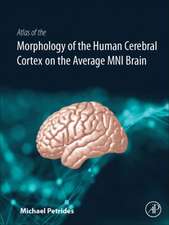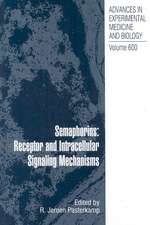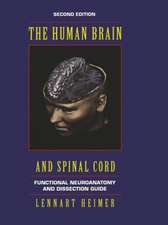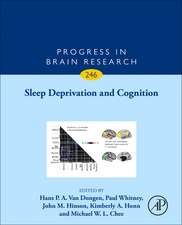Application of Biomedical Engineering in Neuroscience
Editat de Sudip Paulen Limba Engleză Hardback – 26 noi 2019
In turn, the book summarizes the biomedical interventions that are used to understand the neural mechanisms underlying empathy disorders, and reviews recent advances in biomedical engineering for rehabilitation in connection with neurodevelopmental disorders and brain injuries. Lastly, the book discusses innovations in machine learning and artificial intelligence for computer-aided disease diagnosis and treatment, as well as applications of nanotechnology in therapeutic neurology.
| Toate formatele și edițiile | Preț | Express |
|---|---|---|
| Paperback (1) | 954.45 lei 6-8 săpt. | |
| Springer Nature Singapore – 26 noi 2020 | 954.45 lei 6-8 săpt. | |
| Hardback (1) | 960.61 lei 6-8 săpt. | |
| Springer Nature Singapore – 26 noi 2019 | 960.61 lei 6-8 săpt. |
Preț: 960.61 lei
Preț vechi: 1171.47 lei
-18% Nou
Puncte Express: 1441
Preț estimativ în valută:
183.87€ • 199.79$ • 154.55£
183.87€ • 199.79$ • 154.55£
Carte tipărită la comandă
Livrare economică 21 aprilie-05 mai
Preluare comenzi: 021 569.72.76
Specificații
ISBN-13: 9789811371417
ISBN-10: 9811371415
Pagini: 506
Ilustrații: XIII, 490 p. 148 illus., 120 illus. in color.
Dimensiuni: 155 x 235 mm
Greutate: 0.88 kg
Ediția:1st ed. 2019
Editura: Springer Nature Singapore
Colecția Springer
Locul publicării:Singapore, Singapore
ISBN-10: 9811371415
Pagini: 506
Ilustrații: XIII, 490 p. 148 illus., 120 illus. in color.
Dimensiuni: 155 x 235 mm
Greutate: 0.88 kg
Ediția:1st ed. 2019
Editura: Springer Nature Singapore
Colecția Springer
Locul publicării:Singapore, Singapore
Cuprins
Chapter 1. Introduction of Human Physiology.- Chapter 1.1. Basic overview of Human Physiology.- Chapter 1.1. Gene, atom, byte and brain: how neural engineering is transforming neuropsychiatry.- Chapter 2. Introduction to neurodegenerative and regenerative Disorders.- Chapter 2.1. Overview of Neurological Disorders.- Chapter 2.2. Phytoextracts and their derivatives: a potential source to encounter dementia and Alzheimer's disorder.- Chapter 2.3. Biomedical tools in regenerative medicine.- Chapter 3. Emotion, Stress and other Neurological dysfunctions with technological interventions.- Chapter 3.1. Neural mechanism.- Chapter 3.2. Emotion recognition using EEG signal processing.- Chapter 3.3. Emotion recognition using EEG signal processing.- Chapter 4. Neuro disability and Neurorehabilitation.- Chapter 4.1. Pathophysiology of diseases causing physical disability.- Chapter 4.2. Rehabilitation device control using electroencephalography: An overview.- Chapter 5. Introduction to brain images and its classical approaches.- Chapter 5.1. Advanced approaches for medical image segmentation.- Chapter 5.2. Hybrid neurofuzzy approaches for classification of brain MRI images.- Chapter 5.3. Brain imaging technologies and their applications in the identification of neurodegenerative diseases.- Chapter 6. Neural Engineering.- Chapter 6.1. Significance of Neural Engineering.- Chapter 7. Retrain the brain through noninvasive imaging technologies.- Chapter 7.1. Importance of electrical stimulation and transcranial magnetic stimulation.- Chapter 7.1. Feature selection and classification of EEG signals.- Chapter 7.2. Simple computational models for multichannel EEG compression.- Chapter 7.3. Fundamentals of electrooculography and its analysis.- Chapter 8. Nanomaterials involved in therapeutic strategy.- Chapter 8.1. Nanomaterials: an emerging therapeutic strategy for neurological disorders.- Chapter 9. Artificial Intelligence and Computer Aided diagnosis.- Chapter 9.1. Machine learning framework based biomedical signal processing: EEG based studies.- Chapter 9.2. Computer aided diagnosis of epilepsy using bispectrum of EEG signals.- Chapter 10. Modern and futuristic neurological applications of biomedical engineering.- Chapter 10.1. Anatomical optical and microwave real numerical phantoms
Notă biografică
Dr. Sudip Paul is currently an Assistant Professor at the Department of Biomedical Engineering, School of Technology, North-Eastern Hill University (NEHU), Shillong, India. He received his Ph.D. from the Indian Institute of Technology (Banaras Hindu University), Varanasi with a specialization in Electrophysiology and Brain Signal Analysis, and subsequently completed postdoctoral research in Computational Neuroscience under the Biotechnology Overseas Associateship scheme for scientists working in the North Eastern States of India, supported by the Department of Biotechnology, Government of India. He has organized several workshops and conferences, most notably the 29th Annual Meeting of the Society for Neurochemistry, India, and the IRBO/APRC Associate School 2017. He has published more than 90 international journal and conference papers and has filed four patents.
A member of various societies and professional bodies, including the APSN, ISN, IBRO, SNCI, SfN, and IEEE, he received first prize in the Sushruta Innovation Award 2011, sponsored by the Department of Science and Technology, Government of India, and numerous other awards, including a World Federation of Neurology (WFN) travelling fellowship, Young Investigator Award, and IBRO and ISN Travel Awards. He also serves as an editorial board member for a number of international journals.
A member of various societies and professional bodies, including the APSN, ISN, IBRO, SNCI, SfN, and IEEE, he received first prize in the Sushruta Innovation Award 2011, sponsored by the Department of Science and Technology, Government of India, and numerous other awards, including a World Federation of Neurology (WFN) travelling fellowship, Young Investigator Award, and IBRO and ISN Travel Awards. He also serves as an editorial board member for a number of international journals.
Textul de pe ultima copertă
This book focuses on interdisciplinary research in the field of biomedical engineering and neuroscience. Biomedical engineering is a vast field, ranging from bioengineering to brain-computer interfaces. The book explores the system-level function and dysfunction of the nervous system from scientific and engineering perspectives. The initial sections introduce readers to the physiology of the brain, and to the biomedical tools needed for diagnostics and effective therapies for various neurodegenerative and regenerative disorders.
In turn, the book summarizes the biomedical interventions that are used to understand the neural mechanisms underlying empathy disorders, and reviews recent advances in biomedical engineering for rehabilitation in connection with neurodevelopmental disorders and brain injuries. Lastly, the book discusses innovations in machine learning and artificial intelligence for computer-aided disease diagnosis and treatment, as well as applications of nanotechnology in therapeutic neurology.
In turn, the book summarizes the biomedical interventions that are used to understand the neural mechanisms underlying empathy disorders, and reviews recent advances in biomedical engineering for rehabilitation in connection with neurodevelopmental disorders and brain injuries. Lastly, the book discusses innovations in machine learning and artificial intelligence for computer-aided disease diagnosis and treatment, as well as applications of nanotechnology in therapeutic neurology.
Caracteristici
Explores the system-level dynamic function of the brain in health and disease
Evaluates the role of non-invasive neuroimaging techniques for understanding neural processes
Elaborates on advances in biomedical techniques for neurorehabilitation
Reviews the potential of artificial intelligence and nanotechnology in connection with diagnostics and therapeutics for neurological disorders
Evaluates the role of non-invasive neuroimaging techniques for understanding neural processes
Elaborates on advances in biomedical techniques for neurorehabilitation
Reviews the potential of artificial intelligence and nanotechnology in connection with diagnostics and therapeutics for neurological disorders

























